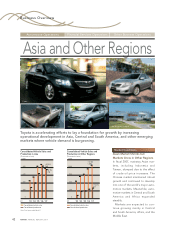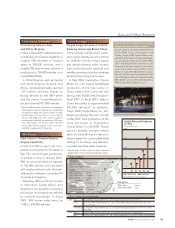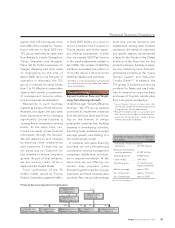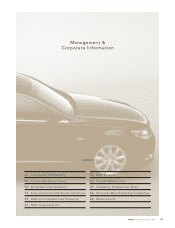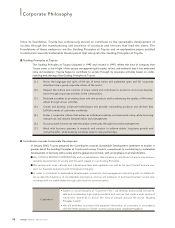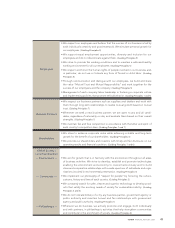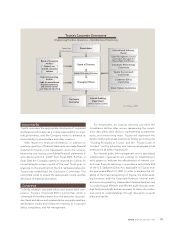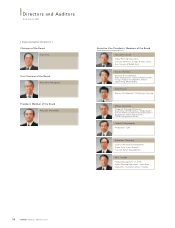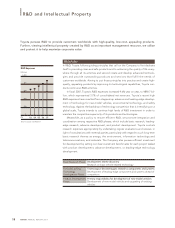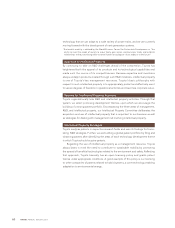Toyota 2007 Annual Report Download - page 52
Download and view the complete annual report
Please find page 52 of the 2007 Toyota annual report below. You can navigate through the pages in the report by either clicking on the pages listed below, or by using the keyword search tool below to find specific information within the annual report.
50 ANNUAL REPORT 2007
Corporate Governance
Toyota’s Basic Approach to Corporate Governance
Toyota’s top management priority is to steadily increase
corporate value over the long term. Further, our fundamen-
tal management philosophy is to remain a trusted corporate
citizen in international society through open and fair busi-
ness activities that honor the language and spirit of the law
of every nation. In order to put that philosophy into prac-
tice, Toyota builds favorable relationships with all of its
stakeholders, including shareholders, customers, business
partners, local communities, and employees. We are con-
vinced that providing products that fully cater to customer
needs is essential to achieve stable, long-term growth. That
philosophy is outlined in the “Guiding Principles at Toyota.”
Further, to explain those principles in more detailed terms,
we prepared and issued the “Contribution towards
Sustainable Development” statement in January 2005.
Through such initiatives, Toyota is taking concrete measures
to reinforce its corporate governance functions and to
become an even more competitive global company.
Specifically, we have introduced a unique management
system focused on prompt decision making for developing
our global strategy and speeding up operations.
Furthermore, we have a range of long-standing in-house
committees and councils responsible for monitoring and
discussing management and corporate activities from the
viewpoints of various stakeholders to ensure heightened
transparency and the fulfillment of social obligations.
Ultimately, however, a well-developed awareness of
ethics among individuals is the key to successful gover-
nance systems. Without such awareness—regardless of the
governance structure of a company—corporate governance
cannot function effectively. Toyota has a unique corporate
culture that places emphasis on problem solving and pre-
ventative measures, such as problem solving based on the
actual situation on the site and highlighting problems by
immediately flagging and sharing them. In other words,
because Toyota’s approach is to build in quality through
manufacturing processes, enhancing the quality of everyday
operations strengthens governance. Toyota’s management
team and employees conduct operations and make deci-
sions founded on that common system of checks and bal-
ances and on high ethical standards.
Toyota’s Management System
Toyota introduced its current management system in 2003.
The main differences between the current system and the
former system are that the current system set a new
non-board position of Managing Officers and reduced the
number of directors. Under the current system, with respect
to various operational functions across the entire Company,
the Chief Officers, who are directors, serve as the highest
authorities of their specific operational functions while non-
board Managing Officers implement the actual operations.
The distinctive feature of this system is that, based on
Toyota’s philosophy of emphasizing developments on the
site, the Chief Officers serve as the link between manage-
ment and on-site operations, instead of focusing exclusively
on management. As a result, this system enables the man-
agement to make decisions directly with on-site operations
by reflecting on-site personnel opinions on management
strategy and swiftly implementing management decisions
into actual operations.
Further, as part of its management reforms, the Com-
pany abolished the retiring directors’ bonus payments
system at the close of the Ordinary General Shareholders’
Meeting in June 2006 in order to further strengthen the link-
age between directors’ remuneration and the Company’s
business results and shareholders’ returns and to establish a
highly transparent remuneration system that reflects duties
and achievements in each term of office.
To monitor the management, Toyota has adopted an
auditor system that is based on the Japanese Corporation
Act. In order to increase transparency of corporate activities,
four of Toyota’s seven corporate auditors are outside cor-
porate auditors. Corporate auditors support the Company’s
corporate governance efforts by undertaking audits in
accordance with the audit policies and plans determined by
the Board of Corporate Auditors. (As of June 22, 2007)
Systems for Ensuring Appropriate Management
As a system to ensure appropriate management, Toyota has
convened meetings of its International Advisory Board (IAB)
annually since 1996. The IAB consists of approximately 10
distinguished advisors from overseas with backgrounds in a
wide range of fields, including politics, economics, the envi-
ronment, and business. Through the IAB, we receive advice
on a diversity of business issues from a global perspective.
In addition, Toyota has a wide variety of conferences and
committees for deliberations and the monitoring of manage-
ment and corporate activities that reflect the views of a range
of stakeholders, including the Labor-Management Council,
the Joint Labor-Management Round Table Conference, the
Corporate Philanthropy Committee, the Toyota Environment
Committee, and the Stock Option Committee.




